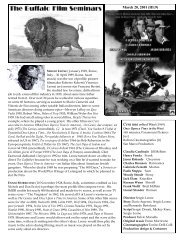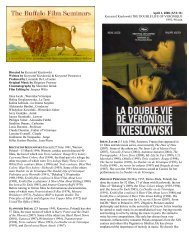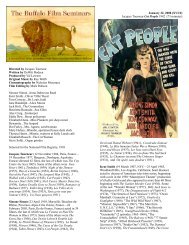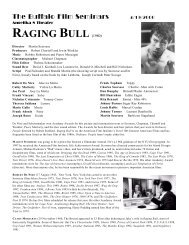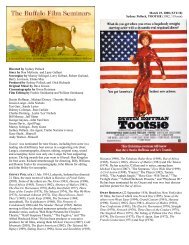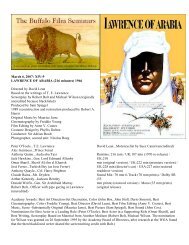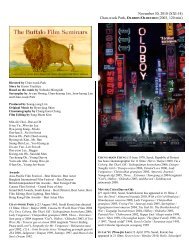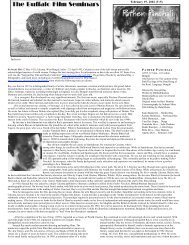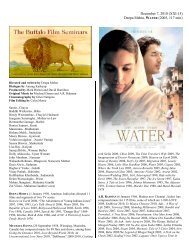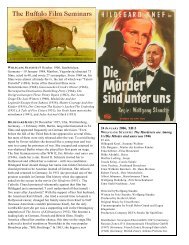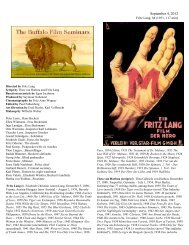The General - CSAC web site - University at Buffalo
The General - CSAC web site - University at Buffalo
The General - CSAC web site - University at Buffalo
You also want an ePaper? Increase the reach of your titles
YUMPU automatically turns print PDFs into web optimized ePapers that Google loves.
THE BUFFALO FILM SEMINARSCONVERSATIONS A BOUT GREAT FILMS WITH BRUCE JACKSON & DIANE CHRISTIANPRESENTED BY THE UNIVERSITY AT BUFFALO AND THE MARKET ARCADE FILM AND ARTS CENTERAUGUST 28, 2001 (IV:): THE GENERAL (1927).BUSTER KEATON (Joseph Frank Ke<strong>at</strong>on VI, 4 October 1895,Piqua, Kansas—1 February 1966, Los Angeles, lung cancer) wrote about30 films, directed nearly 50, and acted in more than 130, often playing himself. His first film role was in <strong>The</strong> Butcher Boy 1917; his lastin Samuel Becket’s Film 1966. Some of the others are A Funny Thing Happened on the Way to the Forum 1966, How to Stuff a Wild Bikini1965, Beach Blanket Bingo 1965, Pajama Party 1964, It's a Mad Mad Mad Mad World 1963, Limelight 1952, Sunset Blvd. 1950, Pardon MyBerth Marks 1940, Palooka from Paducah 1935, Wh<strong>at</strong>! No Beer? 1933, Steambo<strong>at</strong> Bill, Jr. 1928, College 1927, B<strong>at</strong>tling Butler 1926, SevenChances 1925, <strong>The</strong> Navig<strong>at</strong>or 1924, Sherlock, Jr. 1924, Our Hospitality 1923,Paleface 1922, Cops 1922, One Week 1920. He won an honorary AcademyAward in 1960.<strong>The</strong> <strong>General</strong> 1927, 75 minutesMarion Mack.... Annabelle LeeCharles Smith .... Mr. LeeRichard Allen .... His SonGlen Cavender .... Captain AndersonJim Farley .... <strong>General</strong> Th<strong>at</strong>cherFrederick Vroom....Southern <strong>General</strong>Joe Ke<strong>at</strong>on....Union <strong>General</strong>Mike Donlin....Union <strong>General</strong>Tom N awn .... Union <strong>General</strong>Buster Ke<strong>at</strong>on .... Johnnie GrayDirected by Clyde Bruckman, Buster Ke<strong>at</strong>onWritten by Buster Ke<strong>at</strong>on and Charlie Smith,based on W illiam Pittenger’s 18 63 novel, <strong>The</strong>Gre<strong>at</strong> Locomotive ChaseProducers by Buster Ke<strong>at</strong>on, Joseph M. SchenckCinem<strong>at</strong>ography by Bert Haines, DevereauxJenningsFilm Editing by Buster Ke<strong>at</strong>on and ShermanKellArt Direction Fred GabourieBuster Ke<strong>at</strong>on ProductionsUnited A rtists [us]N<strong>at</strong>ional Film Registry, 1989MARION MACK (Joey Marion McCreery, 9 April 1902, Mammoth, Utah—1May 1989, Costa Mesa, California) appeared in only five films: <strong>The</strong> Gre<strong>at</strong>Chase 1963, <strong>The</strong> <strong>General</strong>, <strong>The</strong> Carnival Girl 1926, One of the Bravest 1925, andMary of the Movies 1923.JOSEPH M. SCHENCK (25 December 1878, Rybinsk, Russia—22 October1961, Beverly Hills, a stroke) was one of Hollywood’s legendaryproducers. He produced all of Ke<strong>at</strong>on’s gre<strong>at</strong> films (through Steambo<strong>at</strong>Bill, Jr). Some others of his 90 films wereAs You Like It (1936), Under Two Flags (1936), Hallelujah, I'm a Bum (1933),Rain (1932), Indiscreet (1931), Camille (1927), <strong>The</strong> Duchess of <strong>Buffalo</strong> (1926),Go West (1925), <strong>The</strong> Frozen North (1922), My Wife's Rel<strong>at</strong>ions (1922), <strong>The</strong>Paleface (1922), She Loves and Lies (1920), Convict 13 (1920), <strong>The</strong> Prob<strong>at</strong>ionWife (1919), Her Only Way (1918), Coney Island (1917), His Wedding Night(1917), and Panthea (1917). He won an honorary Academy Award in 1953.CLYDE BRUCKMAN (20 September 1894, San Bernardino, California— 4January 1955, Hollywood, suicide) wrote the screenplays for about 60lightweight films, the most recent of which was Goof on the Roof 1953. Hedirected 21 films, the last of them Man on the Flying Trapeze 1935. Some ofthe others were Horses' Collars 1935, <strong>The</strong> F<strong>at</strong>al Glass of Beer 1933,Everything's Rosie 1931, Leave 'Em Laughing 1928, Should Tall Men Marry?1927, Love 'Em and Feed 'Em 1927, Cowboys Cry for It 1925. “Clyde Bruckmanwas one of th e best gag me n in the business. When Ke<strong>at</strong>on credited himfor co-direction of one of his pictures, he was signed up by Harold Lloyd.In fact , he had no directorial experience <strong>at</strong> all, and the responsibility ofhis new job unnerved him. On top of this, marital troubles led him to drink. In 1955, Bruckman borrowed a gun from Ke<strong>at</strong>on. Aftera meal in a Hollywood restaurant, which he was unable to pay for, he went to the rest room and shot himself.” Kevin Brownlow,<strong>The</strong> Parade’s Gone By.JONATHAN BENJAMIN , who provides the music for this screening, completed his formal musical educ<strong>at</strong>ion in 1989 <strong>at</strong> the ShepherdSchool of M usic, Rice <strong>University</strong>, where he gradu<strong>at</strong>ed Magna Cum Lau de with his Bachelor’s and Master’s of M usic. A winner inthe Leschetizky Intern<strong>at</strong>ional Piano Competition, Jon<strong>at</strong>han became the Principal Pianist for the Houston Ballet Academy, where heremained until 1993. He has since worked in both the classical and jazz idioms, appearing regularly in many venues and has been afe<strong>at</strong>ured pianist for the silent movie series <strong>at</strong> the Houston Museum of Fine Arts and l<strong>at</strong>er the American Museum of the MovingImage. He has performed <strong>at</strong> the last two Intern<strong>at</strong>ion al Ballet Comp etitions in the capacity of Competition P ianist. He currentlyfreelances in the New Y ork area.“<strong>The</strong> Gre<strong>at</strong> Locomotive Chase is a factual account by one of the participants in a cross-country train chase during the American CivilWar. A band of Northern soldiers, led by a professional spy, James J. Andrews, masqueraded as Southern civilians andcommandeered a Southern train, destroying telegraph wires key to the southern war effort as they headed north aboard the train.William A. Fuller, the conductor of the stolen train, pursued them—initially on foot, then in a handcar, and finally with alocomotive he discovered along the way. Assisted by men he recruited during the chase, Fuller reclaimed the train after the
Northerners abandoned it. Ke<strong>at</strong>on added two central fe<strong>at</strong>ures to this story: 1) a second train chase, in which the Northern soldierschase Buster south after he recovers the stolen locomotive; and 2) a romantic plot th<strong>at</strong> parallels the train chase, as Buster’s loveinterest, Ann abelle, is abducted and l<strong>at</strong>er rescued alon g with the train.” Robert Kn opf, <strong>The</strong> <strong>The</strong><strong>at</strong>er and Cinema of Buster Ke<strong>at</strong>on,Princeton, 1999.
“<strong>The</strong> <strong>General</strong> was my pet. It was a page out of history, although I couldn’t use the original finish. Walt Disney tried to do it l<strong>at</strong>er {as <strong>The</strong> Gre<strong>at</strong>Locomotive Chase}, but he couldn’t use the real finish either. Because the Southerners took all eight of those guys and they hanged them.”Buster Ke<strong>at</strong>onAsked years l<strong>at</strong>er why his Civil War depiction looked so much more authentic than Gone With <strong>The</strong> Wind Ke<strong>at</strong>on replied: “<strong>The</strong>y went to anovel; I went to the history books.”“I went to the original loc<strong>at</strong>ion, from Atlanta Georgia, up to Ch<strong>at</strong>tanooga, and the scenery didn’t look very good. In fact, it looked terrible. <strong>The</strong>railroad tracks I couldn’t use <strong>at</strong> all, because the Civil War trains were narrow-gauge. I had to have narrow-gauge, so I went to Oregon. And inOregon, the whole st<strong>at</strong>e is honey-combed with narrow-gauge railways for all the lumber mills. So we got the rolling equipment, wheels andtrucks, and we built the freight train and our passenger train, and we remodeled three locomotives. Luckily, the engines working on theselumber camps were all so doggone old th<strong>at</strong> it was an easy job. . . . At th<strong>at</strong> time they didn’t pay much <strong>at</strong>tention to numbers on engines—theynamed them all. Th<strong>at</strong>’s why the main engine was called ‘<strong>The</strong> <strong>General</strong>’ and the one I chased it with was ‘Texas..’” Buster Ke<strong>at</strong>on, quoted in TomDardis, Ke<strong>at</strong>on: <strong>The</strong> Man Who Wouldn’t Lie Down.“Film actor and director Jackie Chan extends Ke<strong>at</strong>on’s influenc e into the realm of Hong Kong action cinema: he acknowledges hisdebt to Ke<strong>at</strong>on for many of his most dangerous stunts in almost every interview he gives. <strong>The</strong> roots of his affinity with Ke<strong>at</strong>onorigin<strong>at</strong>e in Chan’s early childhood training in Peking opera, the most popular and well-known Chinese the<strong>at</strong>er form.... AlthoughChan employs fast cutting in his fight sequences, shooting them in small segments, he studiously avoids cutting when he performshis most dangerous , Ke<strong>at</strong>on-inspired stunts, retaining Ke<strong>at</strong>on’s practice of using long shots and long takes to prove th<strong>at</strong> heactually performs his stunts. Moreover, Chan further emphasizes his physical virtuosity as a performer by frequently including upto three takes of the same stunt in rapid succession and including outtakes of his failed <strong>at</strong>tempts <strong>at</strong> his stunts during the finalcredits of most of his films.” Robert Knopf, <strong>The</strong> <strong>The</strong><strong>at</strong>er and Cinema of Buster Ke<strong>at</strong>on, Princeton, 1999
“He could tell his story by lifting an eyebrow. He could tell it by not lifting an eyebrow.” Clyde Bruckman.“Wh<strong>at</strong> a raw deal they gav e poor Buster,” said Louise Brooks. “When his wife div orced him, Joe Schenck made sure th<strong>at</strong> he didn ’town his own films, so he could never resell them. <strong>The</strong>y weren’t his own property. Like Lloyd’s or Chaplin’s. He didn’t have a cent.He lived in a magnificent house, on the same scale as a millionaire. But a millionaire’s income comes in every year for ever. PoorBuster lived in a mansion with eight or nine servants on three thousand dollars a week. Schenck was making money out of actors,out of films, out of stories. Wh<strong>at</strong> did it m<strong>at</strong>ter to him or Sam Goldwyn if they lost two thousand to four thousand dollars a week inthe big bridge games? Or went to the Clover Club and lost twenty thousand? <strong>The</strong>y forced the actors, like Buster to take partbecause the moment you haven’t any dough you’re through. You aren’t brave any more. No actor could compete financially with aproducer. Poor little Buster with his three thousand dollars a week, trying to live like a millionaire. It was impossible. So they brokehim.” Louise Brooks, in Kevin Brow nlow’s <strong>The</strong> Parade’s Gone By.“I think Joe Schenck was the first old turtle Darwin saw when the Beagle anchored off the Galapagos—certainly not a cuddly ‘f<strong>at</strong>herfigure’ for Ke<strong>at</strong>on. Anyhow Buster, like Peter Pan, didn’t want a f<strong>at</strong>her. He had his magic world of film production and his houserigged like a Douglas Fairbanks set—or Peter Pan’s ship.” Louise Brooks.In 1928, Ke<strong>at</strong>on made the worst mistake of his life: he signed a contract with MGM “despite the urgent warnings of Chaplin andLloyd and his own misgivings.” <strong>The</strong> salary was good—$3000 a week—but MGM squelched the improvis<strong>at</strong>ory methods he’d usedon all his gre<strong>at</strong> films. <strong>The</strong>y assigned 22 writers to <strong>The</strong> Cameraman. He had marital troubles, began drinking heavily, and sufferedmore and more under studio control. MGM fired him in 1933. <strong>The</strong> next decade was grim: booze, illness, failure. His first marriagebroke up and he married a nurse who helped him dry out. His third marriage was in 1940, when he was 45. Eleanor was a 21-yearolddancer and they were happily married until his de<strong>at</strong>h. Gradually he got cameo roles, such as the bridge scene in SunsetBoulevard and his brief appearance in Ch aplin’s Limelight, their only film together. James Agee’s 1949 article, “Comedy’s Gre<strong>at</strong>estEra” did much to revive interest in Ke<strong>at</strong>on.“In retrospect, Buster Ke<strong>at</strong>on was probably the best comedy director in the business. Chaplin’s use of film was pedestrian bycomparison.” Kevin Brownlow, <strong>The</strong> Parade’s Gone By, 1968.“R<strong>at</strong>her to his bewilderment, Ke<strong>at</strong>on found himself elev<strong>at</strong>ed from near-oblivion to a position of equality with–or even superiorityto–Chaplin in the pantheon of film comedians, a critical estim<strong>at</strong>ion th<strong>at</strong> still holds good. ‘Ke<strong>at</strong>on,’ st<strong>at</strong>ed Andres Sarris, ‘is nowgenerally acknowledged as the superior director and inventor of visual forms. <strong>The</strong>re are those who would go furthe r and claimKe<strong>at</strong>on as pure cinema as opposed to Chaplin’s the<strong>at</strong>rical cinema.’ ...<strong>The</strong> climax of Ke<strong>at</strong>on’s return to fame came <strong>at</strong> the 1965 VeniceFilm Festival, where Film, a 22-minute short written for him by Samuel Beckett, was premiered. L<strong>at</strong>er th<strong>at</strong> day, <strong>at</strong> the evening gala,Ke<strong>at</strong>on was given a standing ov<strong>at</strong>ion of unparalleled fervor. He was touched and delighted, but told Lotte Eisner afterw ards, ‘Sureit’s gre<strong>at</strong>–but it’s all 30 years too l<strong>at</strong>e.’ He continued working to within 3 m onths of his de<strong>at</strong>h, although there were now far moreoffers than he could fulfill.” World Film Directors I, 1987.“I was a veteran before I went into pictures. I was twenty-one years old by then. I made my first picture when I was 25. Pacing–for fast actionyou cut things closer than normal. For a dram<strong>at</strong>ic scene, you lengthen them out a little bit more. Once we’ve seen the scene on the screen, weknow wh<strong>at</strong> to do. We get in the cutting room and run down to where the action is. <strong>The</strong>re–as he goes out the door, rip it. Th<strong>at</strong>’s it. Give him thenext shot. Get it down to where he’s just coming through the door. Get the two spliced together. . . .“<strong>The</strong>re was one big advantage in those days, when you owned your own studio, and you were the only company in there. <strong>The</strong>skeleton of your outfit—th<strong>at</strong>’s your technical man, your prop man, your head electrician—these people are all on salary with you for 52 weeksof the year. So if I’m sitting in the cutting room and the picture’s been finished, and I want an extra shot, I can do it....Th<strong>at</strong> would cost me thegasoline of the car and the film...about two dollars and thirty-nine cents. You try th<strong>at</strong> <strong>at</strong> any major studio today, and I’ll tell you the least youcould get th<strong>at</strong> scene for would be around $12.000” Buster Ke<strong>at</strong>on“After wh<strong>at</strong> must have been one of history’s most agreeable childhoods, spent traveling with his family’s knockabout act andlearning the tricks of the comic trade on turn-of-the-century vaudeville stages, Buster Ke<strong>at</strong>on as a youn g man entered the m ovies.First serving several apprentice years, he performed from 1917 through 1919 as a supporting actor with F<strong>at</strong>ty Arbuckle’s ComiqueFilm Corpor<strong>at</strong>ion, and in 1920 as the leading actor in one Metro fe<strong>at</strong>ure, <strong>The</strong> Saphead. <strong>The</strong>n, in the decade th<strong>at</strong> followed, the lastgre<strong>at</strong> golden-tinted years of the silent screen, he became both the star and principal cre<strong>at</strong>or of nineteen two-reelers and twelvefe<strong>at</strong>ure-length films.“Except for the last two fe<strong>at</strong>ures, produced under growing difficulties after Ke<strong>at</strong>on had been contracted to Metro-Goldwyn-Mayer, these movies of th e twenties are all independent Ke<strong>at</strong>on cre<strong>at</strong>ions. He and his crew in the Ke<strong>at</strong>on Studiocontrolled every aspect of the films’ making and were under no constraints to please anyone but themselves. <strong>The</strong>y ended uppleasing not only themse lves but a large contemporary audien ce, and, since the rediscovery of Ke<strong>at</strong>on in the nineteen-sixties, anew and growing audience, which still laughs in all the funny places.” Daniel Moews, Ke<strong>at</strong>on: <strong>The</strong> Silent Fe<strong>at</strong>ures Close UpFewpeople know more about Ke<strong>at</strong>on than RANJIT SANDHU, who has helped us prod uce the Bu ffalo Film Seminars since we started inSpring 2000. <strong>The</strong> best starting place for inform<strong>at</strong>ion about Ke<strong>at</strong>on online is Ranjit’s article on our <strong>web</strong><strong>site</strong> <strong>at</strong> the entry for <strong>The</strong> <strong>General</strong>(www.buffalofilmseminar.com). This the bibliographical note Ranjit prepared for th<strong>at</strong> article:
Perhaps the best place to start learning about Ke<strong>at</strong>on’s life and work is the <strong>web</strong> <strong>site</strong> oper<strong>at</strong>ed by the Damfinos— <strong>The</strong> Intern<strong>at</strong>ional Buster Ke<strong>at</strong>on Society,which can be found <strong>at</strong> http://www.busterke<strong>at</strong>on.com. A British-based <strong>web</strong> <strong>site</strong> can be found <strong>at</strong> http://www.bigfoot.com/~blinking_buzzards. Anothersuperb source is the three-volume video set by Kevin Brownlow and David Gill called Buster Ke<strong>at</strong>on: A Hard Act to Follow, which was available onlaserdisc and VHS from HBO, but is now out of print. It is still available as a single cassette from Connoisseur/Academy Video in England in PAL-systemVHS. An imp ressive article/interview is pu blished as chapte r 43 of Kevin Brown low’s <strong>The</strong> Parad e’s Gone B y... (Berkeley: <strong>University</strong> of California Press,1968). <strong>The</strong> best b ooks about Buste r Ke<strong>at</strong>on’s life are Oliver Lin dsey Scott’s Buster Ke<strong>at</strong>on: <strong>The</strong> Little Iron Man (New Zealand: priv<strong>at</strong>ely printed [1995]),Rudi Blesh’s Ke<strong>at</strong>on (New Yo rk: Macm illan, 1966 ), and Bust er Ke<strong>at</strong>on ’s autobio graphy (as t old to C harles Sam uels), My Wonderful World of Slapstick(Garden City, N .Y.: Doubleday & Compan y, 1960). <strong>The</strong> best b ook on Ke<strong>at</strong>on ’s work is Jim Kline’s <strong>The</strong> Complete Films of Buster Ke<strong>at</strong>on (New York:Citadel Press, 1993 ). David Macleo d’s <strong>The</strong> Sound of Buster Ke<strong>at</strong>on (London: Buster Books, 1995), which deals only with the post-independ ence work, isalso highly recom mended. D aniel Moews’s Ke<strong>at</strong>on: <strong>The</strong> Silent Fe<strong>at</strong>ures Close Up contains an invaluable final section entitled “Bibliographical andFilmographical Comments.” Alan Schneider wrote a (self-deprec<strong>at</strong>ingly) hilarious and touching description of his work with Ke<strong>at</strong>on in an essay called“On Directing Film.” Ke<strong>at</strong>on, dismayed by wh<strong>at</strong> he thought was an insane script, was not his usual joking and laughing self on the set, but taciturn andsubdued, giving Schneider th<strong>at</strong> wrong impression th<strong>at</strong> the somber <strong>at</strong>titude he had on screen was a carry-over from real life. This essay is included inSamuel Becke tt’s Film: Complete Scenario / Illustr<strong>at</strong>ions / Production Shots (New York: Grove Press / Evergreen, 1969), and was l<strong>at</strong>er republished, with afew modific<strong>at</strong>ions, as “<strong>The</strong> Sam and Buster Show, 1964– 1965,” a chapter in Schneider’s unfinished autobiography Entrances : An Ame rican Dire ctor’sJourney (New York: Viking P enguin, 1986). A ch arming and inte nsely researched bo oklet on the Ac tors’ Colony, which Buster’s f<strong>at</strong>her helped found justoutside of Mu skegon, Michigan, an d where Buster ha d his happiest ch ildhood m emories, is Marc O kkonen and Ro n Pesch’s Buster Ke<strong>at</strong>on and theMuskegon Connection: <strong>The</strong> Actors’ Colony <strong>at</strong> Bluffton, 1908–1938 (Muskegon: priv<strong>at</strong>ely printed, 1995). M<strong>at</strong>erial on the making of <strong>The</strong> <strong>General</strong> can befound in som e of the above ite ms, but the best sou rce is <strong>The</strong> Day Buster Smiled (Cottage Grove, Oregon: Cottage Grove Historical Society, 1998).To th<strong>at</strong> we’d add Marion Meade’s Buster Ke<strong>at</strong>on: Cut to the Chase (NY Da Capo, 1997), which is not only a pretty good biography,but also includes an excellent 67-page filmography by Jack Dragga and some of Ke<strong>at</strong>on’s favorite recipes, including these two:LOBSTER JOSEPHThis is Ke<strong>at</strong>on’s recipe for his all-time favorite dish, purloined over a period of years from a Parisian restaurant. Serve with bite-size boiledpot<strong>at</strong>oes, green salad, and sourdough bread. Bread and pot<strong>at</strong>oes are dunked in the sauce.1 pint sour cream1 square butter, ¼ pound2 30-ounce cans solid pack tom<strong>at</strong>oes (unseasoned)1 teaspoon salt¼ teaspoon pepper4 medium lobsters (cooked)1 ounce brandy2 ounces sweet sherryMelt butter. Blend in sour cream, add tom<strong>at</strong>oes (putting aside tom<strong>at</strong>o juice). Combine sherry and brandy in separ<strong>at</strong>e pan. Burn outmost of the alcohol and ad d to sauce. Add tom<strong>at</strong>o juice as needed to desired consistency. Cut lobster into bite size and he<strong>at</strong> insauce.Fish fillets can be substituted for the lobster. M elt butter and quickly saute 1 pound fille ts (sole is goo d). Rem ove towarm dish. Do not overcook. Add w ell-drained tom <strong>at</strong>oes to remaining butter, mixing and chopping with spoon. Add saltand pepper. When tom<strong>at</strong>o-butter mixture is hot (but not boiling) mix in sour cream, a bit <strong>at</strong> a time. Add brandy and sherry,or wh ite port. Mix w ell.PORKPIE HATKe<strong>at</strong>on’s trademark h<strong>at</strong>s were homemade. <strong>The</strong> first was cre<strong>at</strong>ed in 1917 for <strong>The</strong> Butcher Boy.1 Stetson h<strong>at</strong>, which has ben cut down to size3 heaping teaspoons granul<strong>at</strong>ed sugar1 teacup warm w<strong>at</strong>erMix sugar and w<strong>at</strong>er. Wet the top and bottom of the brim. Smooth it out on a clean, hard surface. Allow to dry until still.“ Idid the early ones myself, always—and then I trained my wife,” Ke<strong>at</strong>on said.Join us next Tuesday, September 4 th , forLouise Brooks in Georg Pabst’s erotic masterpiece, “Pandora’s Box”. <strong>The</strong> film will be accompanied on electronicpiano by the gre<strong>at</strong> Philip Carli, who gave such a stunning performance last year with “<strong>The</strong> Big Parade.”



